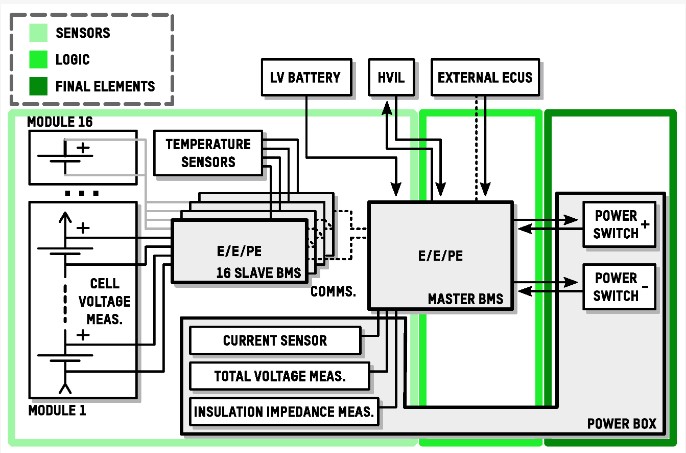🔋 Ensuring Functional Safety in Battery Management Systems (BMS): Key Requirements 🔋
With the rise of electric vehicles (EVs) and energy storage systems, the functional safety of Battery Management Systems (BMS) is paramount. Here’s a detailed overview of essential safety requirements to enhance BMS reliability and performance:
🔴 Battery State Monitoring
✅Real-Time Monitoring: Implement sensors to monitor voltage, current, temperature, and state of charge (SOC).
✅Redundant Systems: Ensure redundant monitoring to detect sensor failures.
✅Diagnostics: Provide real-time diagnostics for early fault detection.
🟢 Cell Balancing and Management
✅Balancing Techniques: Implement active/passive cell balancing to maintain uniformity.
✅Voltage Monitoring: Continuously monitor cell voltages to detect imbalances.
✅Thermal Management: Ensure effective thermal management to prevent overheating.
🟡 Overcharge and Overdischarge Protection
✅Voltage/Current Limits: Set precise limits to prevent overcharge and overdischarge.
✅Cutoff Mechanisms: Implement mechanisms to disconnect the battery if limits are exceeded.
✅Alarms and Notifications: Provide alerts for abnormal conditions.
🔵 Short Circuit and Overcurrent Protection
✅Fast-Acting Fuses: Use fuses and circuit breakers to protect against short circuits.
✅Current Sensing: Integrate current sensing and limiting features.
✅Fault Detection: Provide mechanisms for real-time fault detection and isolation.
🔴 Thermal Management
✅Cooling/Heating Systems: Implement systems to manage battery temperature.
✅Temperature Monitoring: Monitor temperature across cells and modules.
✅Thermal Runaway Detection: Provide detection and mitigation strategies.
🟢 Communication and Data Integrity
✅Robust Protocols: Use reliable communication protocols (e.g., CAN, LIN).
✅Error Detection: Implement error detection and correction mechanisms.
✅Data Logging: Ensure traceability for diagnostic purposes.
🟡 Functional Safety Management
✅Safety Culture: Foster a safety culture emphasizing functional safety at all levels.
✅Compliance: Ensure adherence to standards (e.g., ISO 26262, IEC 61508).
✅Safety Audits: Conduct regular audits and reviews.
🔵 Verification and Validation (V&V)
✅System Testing: Perform extensive testing, including Hardware-in-the-Loop (HIL) and Software-in-the-Loop (SIL) simulations.
✅Fault Injection Testing: Simulate faults to verify fault tolerance.
✅End-to-End Validation: Validate safety mechanisms comprehensively.
🔴 Continuous Monitoring and Updates
✅Safety Performance: Implement continuous monitoring of safety performance.
✅Software Updates: Provide regular updates and patches.
✅Periodic Assessments: Conduct regular safety assessments and improvements.
At Xenban we help companies to define, deploy and implement functional safety requirements.
Please visit www.xenban.com to know about products and services.

